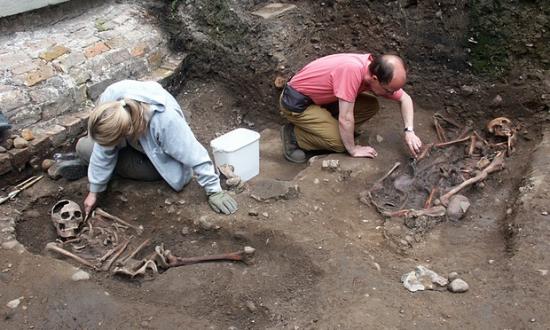Maev Kennedy
Source - http://www.theguardian.com/uk-news/2016/jan/19/origins-of-yorks-decapitated-romans-traced-by-genome-technology?
Scientists reveal that headless men believed to be gladiators have descendants in Wales – and one hailed from Middle East
 The Roman skeletons were found at Driffield Terrace in York with their skulls placed between their legs, at their feet or on their chests. Photograph: York Archaeological Trust
The Roman skeletons were found at Driffield Terrace in York with their skulls placed between their legs, at their feet or on their chests. Photograph: York Archaeological Trust
The origins of a group of men whose decapitated corpses were discovered in a Roman cemetery in York have been traced through genome technology. It has been revealed that one man came from as far away as modern Syria or Palestine, and that the descendants of others now live in Wales.
The 1,800-year-old skeletons of more than 80 individuals, all aged under 45 when they died, have been puzzling archaeologists since they were excavated more than a decade ago by the York Archaeological Trust. The men – many of whom were taller than average and well built – may have been gladiators, soldiers or criminals whose violent deaths were arena entertainment.
The graveyard was discovered beneath gardens at Driffield Terrace, on land that would have been on the edge of the Roman city. The site is believed to be a special burial place for people who fought as gladiators or died in the arena.
Most of the men were decapitated before or just after their deaths; their skulls were found tucked between their legs, at their feet or placed on their chests. Despite their gruesome end, many of the men were buried with honour, alongside goods including the bones of what had been joints of meat. Most of the skeletons had recent and old injuries from battle or combat, and all except one had brown hair and brown eyes.
The pioneering analysis – the results of which were published this week in Nature Communications – was carried out by scientists from the universities of York, Durham, Reading, Sheffield, Trinity College Dublin and the University Medical Center Utrecht. Working with experts from York Osteoarchaeology, the scientists studied radioactive isotopes that can show where individuals spent their early lives. They also ran a whole genome analysis on nine skeletons: seven from the Roman cemetery in York, plus a pre-Roman iron-age woman and an Anglo-Saxon man.
The tests revealed that most of the York Romans had genomes similar to the pre-Roman iron-age woman, found in Melton in east Yorkshire, suggesting that they were from the region. Isotope variations, however, indicated that some had spent time outside Britain. Many of the men had suffered poor health in childhood. Comparison with modern samples showed that the nearest descendants of the Roman Britons were no longer in Yorkshire but in Wales.
Prof Dan Bradley, of the molecular population genetics laboratory at Trinity College Dublin, said: “It confirms the cosmopolitan character of the Roman empire, even at its most northerly extent.”
Christine McDonnell, head of curatorial and archive services at the York Archaeological Trust, said the isotope and genome research was a remarkable advance in understanding populations and migration patterns in the ancient world. “This hugely exciting pioneering work will become the new standard for understanding the origins of skeletons in the future,” she added. “As the field grows and costs of undertaking this kind of investigation fall, we may be able to refine our knowledge of exactly where the bodies were born to a much smaller region.”